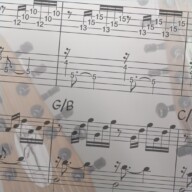Gymnopédie n°1 (Erik Satie)
3.00€
Composer : Erik Satie
Versions:
- Instrumental
Accordage:
- Standard
- Matched Reciprocal
Audio:
- Audio mp3
Description
Gymnopedie n°1
Erik Satie
Composed by Erik Satie (French composer 1866/1925)in 1888, the three Gymnopédies are slow waltzes written for solo piano. They are inspired by Gustave Flaubert’s novel Salammbô and ancient dances performed in Sparta. They are minimalist and melancholic works, perhaps the ancestor of “Ambient Music”. Brian Eno cites Satie as one of his inspirations.
For the Stick version I chose to reduce the piano chords only with the left hand on the bass block, choosing for each measure the fondamental and the most characteristic note of the chord. For example on G major 7 the root (G) and the third (B) and on D major 7 the root (D) and the 7th major (C #) and so on for each bar. This puts all the harmony of the piece and frees the right hand to play the melody. The two notes of the bass and the sustained notes of the melody allow to hear very clearly the harmonic richness of this composition.
The rhythm is almost the same all along the piece, which reinforces the hypnotic side of the “song”. It is a slow waltz in 3 beats, the fundamental in dotted half note which thus lasts all the measure and the characteristic note in half note on the 2 and 3° beats.
The structure is quite original. The form rotates over 39 bars with a reprise. The first 32 bars are identical both times, then at the repeat we go to a coda with strange and dissonant harmonies: bar 41, Dm/E with an F in the melody (forming a 9b), bar 42 F/E forming a 9b chord in the bass (idem bar 44) and finally bar 45 an E minor with an F natural in the melody. This illustrates Satie’s desire to move away from the codes of classical music. The 1st Gymnopedie offers a great contrast between the very consonant first part and this very harmonically tense end.
I chose to figure out the chords in the manner of a jazz grid. This is not at all in the concept of classical harmony but can allow you to develop solos to make the form last, the piece being quite short. And the harmonic canvas is really nice to develop an improvisation.














Reviews
There are no reviews yet.